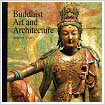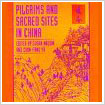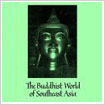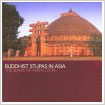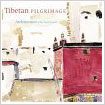The assemblage is often greeted by villagers along the route who expect a blessing (tuk mon or blessing with lustral water). The founder of the Dhammayietra was Maha Ghosananda, a Buddhist monk who ranked among the higher echelons of the Cambodian sangha; he led the first Dhammayietra as he returned from exile following the war. Dhammayietra is often translated as "pilgrimage of truth."
The Pilgrimage of Truth
Since 1992 an annual ‘Dhammayietra’ - literally, a ‘pilgrimage of truth’- has been held in war-torn Cambodia. The hundreds of participants walked over long distances for peace and reconciliation, providing an example of a peaceful alternative to the norm of violence that has prevailed in Cambodia.
The tragedy that befell Cambodia when the Khmer Rouge seized power in 1975 is widely known. Up to 2 million people died from disease, hunger, torture, and executions. Vietnamese forces drove the Khmer Rouge from power three years later, but violence has continued to plague the country.
Despite the signing of a formal Peace Treaty in 1991, and the presence during 1992 and 1993 of over 22,000 UN peace-keepers, many thousands of lives have been lost, many more thousands of Cambodian citizens have been wounded, and Cambodians continue to suffer severe economic hardships as a result of the continuing conflict. The rule of law does not exist. Human rights continue to be violated, and those parts of the country that have not been divided up among the various political factions are the domain of bandits and plunderers.
Peace-making in such a climate is a most difficult endeavour. Yet there are ordinary citizens, acting out of their belief in the power of non-violence and their hope for a more peaceful future, who refuse to give in to the climate of violence that has held sway in Cambodia for the last thirty years.
Perhaps the best known, inspiring, and successful of these efforts at non-violent organising has been the Dhammayietra. Each was both a spiritual pilgrimage and a physical pilgrimage through the Cambodian countryside. Cambodia is, of course, a predominantly Buddhist society, and the Dhammayietra walks are a very specific application of Buddhist teachings on the linkage between spiritual awareness and non-violent conflict resolution. Maha Ghosananda, one of Cambodia’s most respected Buddhist monks, was instrumental in organising the first Dhammayietra, and served as the spiritual leader for that first walk and each succeeding walk.
 Maha Ghosananda, The Gandhi of Cambodia
Maha Ghosananda, The Gandhi of Cambodia
Maha Ghosananda, who is often referred to as the ‘Cambodian Gandhi’, argues for a process of reconciliation derived from a deep-rooted sense of compassion.
‘It is a law of the universe that retaliation, hatred, and revenge only continue the cycle and never stop it,’ he has said. ‘Reconciliation does not mean that we surrender rights and conditions, but rather that we use love. Our wisdom and our compassion must walk together. Having one without the other is like walking on one foot; you will fall. Balancing the two, you will walk very well, step by step.’
Dhammayietra's Social Action Philosophy
The central value that is the key to both the power and the success of the Dhammayietra is compassion, viewed from a Buddhist perspective as both the means and the end of personal and social liberation. Compassion is considered to be the one virtue which enables peacemakers to persist in non-violent action when confronted with violence and frustration. While members of the Dhammayietra movement recognise that the development of compassion is a long-term process, they offer several lessons from Buddhist practice as strategies that can be useful in cultivating it. Compassion serves as a defence against fear, which is seen as a precursor to violence.
As a corollary to the cultivation of compassion, the Dhammayietra philosophy advocates the cultivation of ‘active mindfulness’. By this it is meant that when an individual is confronted with a difficult situation, he or she is capable of either quickly acting - or not acting, if that is more appropriate - with clarity of mind, based on one’s own knowledge, experience, and understanding, rather than reacting to and being controlled by that situation.
If these two qualities are aspired to for the individual participants of a Dhammayietra, the quality that is essential to guarantee the integrity and credibility of the group process is non-partisanship. In Buddhist terminology, the Dhammayietra treads the ‘Middle Path’.
The Dhammayietra is making a statement for peace and non-violence, and against policies, strategies, and actions that lead to violence, but that stance does not imply that it is opposing one side or another in a violent conflict. The position of the Dhammayietra is a clear expression of Gandhi’s admonition to ‘oppose the evil, not the evil doer.’
Dhammayietra pilgrims
All participants in the Dhammayietras prepared for their month-long walks by attending non-violence training programs at one of several locations in Cambodia. The first sessions at these training programmes were taken up with fundamentals: the philosophy of the walk, an introduction on meditation for peace, and an understanding of how basic Buddhist concepts can be applied to the difficulties of everyday life.
Subsequent sessions provided examples of peacemaking, theory on non-violence, strategies for handling fear, and role-playing sessions to familiarise participants with potential situations they might encounter during the walk. Because of the serious risks of injury from unexploded mines, the training also included sessions on mine awareness, provided by non-governmental agencies.
Such training not only prepares the walkers for the Dhammayietra itself, but they create a large network of individuals trained in non-violent action and theory, capable of passing that knowledge on to other members of their own communities. From 1992 through 1997, thousands of people attended non-violence training sessions.
The Dhammayietra is an expression of commitment to non-violence, but it is also a complicated ongoing event, with somewhere between 400 and 700 participants, and it thus requires order, discipline, and logistical planning. Over the five years of the Cambodian Dhammayietras, an organisational structure has developed in response to difficulties encountered along the way.
In later years, overall co-ordination was placed in the hands of a committee of 17 people, all of them Cambodian monks, nuns, or lay people (in earlier years a smaller committee including expatriates co-ordinated the walks). The participants were divided into groups of about ten walkers, each with a group leader selected by the members. These leaders participated in meetings with the walk committee to assure a democratic decision-making process. Other members of the walk groups were designated to serve as assistants and representatives, with responsibilities for the distribution of essential supplies, food, water and information.
Perhaps the most important provision introduced in later years was a set of guidelines which constituted a framework within which the Dhammayietra could be expected to proceed smoothly. These stipulated that participants would attend the pre-walk non-violence training and refrain from riding in vehicles, using drugs, carrying weapons, wearing uniforms, or carrying flags.
Beginning with the fourth Dhammayietra in 1995, walk organisers incorporated a public education element. This included the distribution of pamphlets, dissemination of a ‘Peace Health’ message articulating the belief among health workers that war ‘is the number 1 health problem in Cambodia’, and public talks at villages along the route of the walk.
At these talks, Maha Ghosananda would spread his message that Buddhism can serve as a basis for social reconciliation and compassion. Such events also provided opportunities for landmine awareness trainers to make presentations to local residents. Another focus, in 1996, was on the need to preserve Cambodia’s forests, which are a crucial element of the Cambodian environment, and an important symbol of renewal in Buddhism. Unfortunately, serious damage has been done to Cambodia’s rich timber resources, and one of the important sources of income for combatants in the Cambodian civil war has been the profits earned from exploiting those resources.
History of Dhammayietras
Although non-violent action is undertaken in the hope that a principled commitment to non-violence can provide a degree of protection for participants, non-violent action in a climate of violence remains a risky endeavour. This was vividly and tragically demonstrated during the Dhammayietras of 1993 and 1994.
The first Dhammayietra in 1992 had succeeded beyond its organisers’ expectations. Walkers had begun the Dhammayietra in refugee camps on the Thai side of the Thai-Cambodian border, and had walked to Phnom Penh. As a result of the walk, many refugees had been reunited with family members they had not seen since the 1970s, and the walk had succeeded - at least for a time - in breaking through the insidious climate of fear that pervaded the society. Several thousand ordinary Cambodians had spontaneously joined the walk, and tens of thousands demonstrated their support for the walkers as they passed through provincial seats along the way to the capital.
But at the beginning of the second Dhammayietra, from Siem Reap in the north of the country to Phnom Penh, several walkers were wounded when they were caught in a crossfire between government forces and Khmer Rouge fighters. Walkers also braved ongoing shelling which, though not directed at the walk, occurred on a daily basis along the first part of the route. The walk continued nonetheless, and by the time it reached the capital, the total number of participants had swelled to about 3,000.
‘Reconciliation does not mean that we surrender rights and conditions, but rather that we use love.’
The following year, with a fragile coalition between former combatants in place in Phnom Penh after UN-supervised elections, the organisers elected to walk from Battambang to Siem Reap - directly through a region of the country where the civil war still raged. Their hope was to maintain ‘a zone of peace’ around the walk. On the seventh day of the Dhammayietra, the walkers were accompanied by unarmed soldiers who were showing them a mine-free route, and as they walked, they encountered other armed soldiers conducting military patrols.
‘Suddenly,’ wrote American participant Liz Bernstein, ‘the walkers encountered a group of [Khmer Rouge] soldiers and a fire fight ensued. Bullets and rockets flew as the walkers lay on the ground.’ The Dhammayietra had once again been caught in a crossfire, and this time three walkers were killed. Following this incident, there was considerable confusion about whether or not the walk would continue, and some organisers and participants left the walk, while others continued, by an alternative route, to the end.
After the sobering experience of 1994, organisers redoubled their efforts to provide adequate training to participants and to ensure that no soldiers would accompany the Dhammayietra.
The walks in 1995 and 1996 proceeded without violence, with the focus in 1995 on the international campaign to ban landmines, and the focus in 1996 on deforestation (including the planting of thousands of trees along the route) and the ongoing civil war.
Impact of Dhammayietras
The risks and frustrations of the Dhammayietra are all too obvious - walkers have been killed and injured, and civil war and lawlessness still reign in Cambodia. What then can be said about the impact?
Canadian anthropologist, Monique Skidmore, observed the Dhammayietra was a ‘new cultural ritual of remembering,’ and that ‘through the creation of new collective memories it will allow some Cambodians to emerge from the culture of violence created by the last 20 years of war’.
Australian non-violence trainers, Robert Burrowes and George Lakey, both believe that the Dhammayietras build ‘non-violent solidarity’ between the participants who pass through zones of conflict and the local people who must endure the suffering caused by violence.
Such solidarity, writes Yeshua Moser-Puangsuwan, of the Southeast Asia office of Non-violence International, ‘further generates awareness of, and support for grassroots initiatives to halt the war. It also generates solidarity actions by grassroots activists in other parts of the world.’ Moser-Puangsuwan believes that in this way the Dhammayietra can serve as a model for non-violent struggle in other parts of the world.
Awareness and solidarity may not, in and of themselves, be enough to end decades of violence, but, as one villager along the route of the walk said, ‘It is the only thing that gives us hope. Every other day all we know is war.’ It is in that fertile medium of hope that the seeds of an enduring peace can take root.
Buddhist Prayer for Peace
The suffering of Cambodia has been deep.
From this suffering comes Great Compassion.
Great Compassion makes a Peaceful Heart.
A Peaceful Heart makes a Peaceful Person.
A Peaceful Person makes a Peaceful Family.
A Peaceful Family makes a Peaceful Community.
A Peaceful Community makes a Peaceful Nation.
And a Peaceful Nation makes a Peaceful World.
May all beings live in Happiness and Peace.
‘Step by Step: Meditations on Wisdom and Compassion’
by Maha Ghosananda
Source: European Centre for Conflict Prevention: People Building Peace
For more info, contact:
Dhammayietra Centre for Peace and Nonviolence
Wat Sampeo Meas, P.O. Box 144, Phnom Penh
Tel: +855 129 24 248
Fax: +855 233 64 205
Selected Bibliography:
European Centre for Conflict Prevention (ECCP). 1999. People Building Peace — 35 Inspiring Stories from Around the World (Utrecht, Netherlands: ECCP).
Khemacaro, Yos Hut.“Steering the Middle Path: Buddhism, Non-Violence and Political Change in Cambodia.” Online at: www.c-r.org
“Maha Ghosananda to Receive Fifteenth Niwano Peace Prize.” Online at: www.interfaith-center.org
“One Million Kilometres for Peace: Five Years of Steps Towards Peace in Cambodia.” Online at: www.uq.net.au




